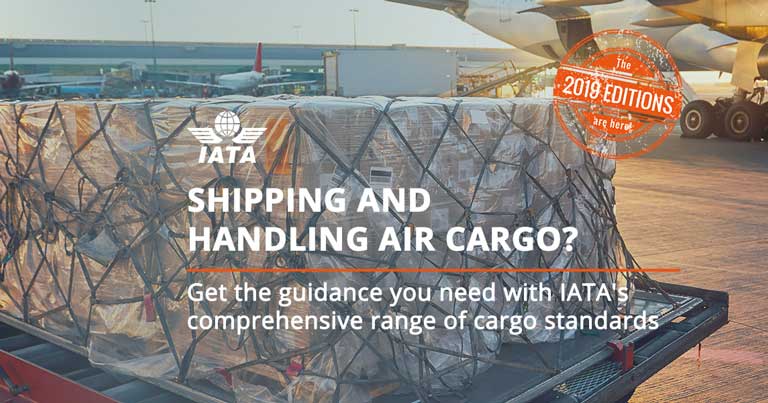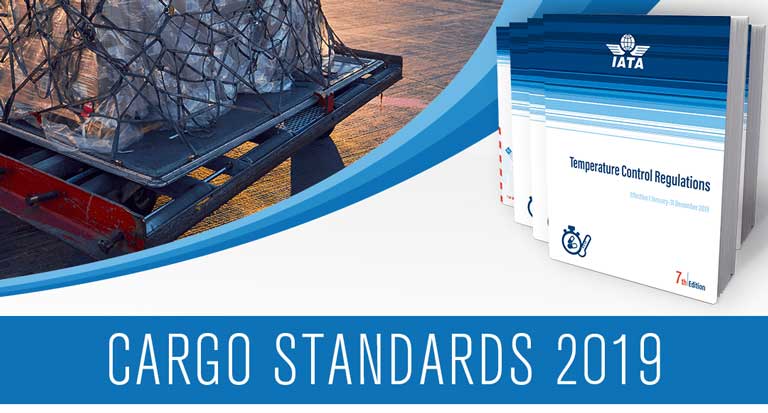
IATA, together with industry groups, works to drive efficiency in all areas of cargo operations through the development and implementation of global cargo standards, addressing all aspects of cargo acceptance and handling.
Cargo handling is performed at thousands of airports all over the world by hundreds of companies, big and small. This poses a high potential risk for deviations in quality of handling. IATA actively drives the development of ground handling operations standards, best-practice processes and procedures and promotes global consistency and harmonisation.
IATA, together with industry stakeholders, works to drive efficiency in all areas of air cargo operations through the development and implementation of global cargo standards, addressing all aspects of cargo acceptance and handling.
The IATA Cargo Standards are the industry reference for air cargo shipping and handling. Updated every year, these standards are presented in the form of a comprehensive range of manuals, providing the ultimate information source to ensure cargo shipments and operations are safe, efficient and compliant with international and local regulations.
Timely and industry-recognised guidance:
- Whatever the cargo commodity – live animals, perishable cargo, pharmaceutical products, or dangerous goods;
- For the complete end-to-end air cargo handling operations, based on consolidated information from all individual carrier cargo handling manuals;
- On all aspects – technical, operational and regulatory – of your ULD operations;
- On overall standards and procedures pertaining to cargo facilities, connectivity and data exchange, as well as roles and responsibilities in cargo relationships.

Many important changes and updates have been made to the 2019 Air Cargo Standards, including the Dangerous Goods Regulations (DGR).
Many important changes and updates have been made to the 2019 Air Cargo Standards, including the Dangerous Goods Regulations (DGR). Here is a brief overview of some of the notable changes, effective 1 January 2019:
Dangerous Goods Regulations (DGR) 60th edition:
- The 60th edition of the DGR incorporates all amendments made by the ICAO Dangerous Goods Panel in developing the content of the 2019–2020 edition of the ICAO Technical Instructions, as well as changes adopted by the IATA Dangerous Goods Board.
- The new edition’s notable changes encompass new requirements for lithium batteries, as well as significant changes to the provisions for the classification of corrosive substances and in particular the methods to assign packing groups to mixtures.
Review the summary of the main changes here.
Live Animal Regulations (LAR) 45th edition:
- Includes new recurrent training requirements:
- Training is paramount to effective implementation, therefore the 45th edition of the IATA Live Animals Regulations (LAR) is introducing recurrent training that must be provided within 36 months of previous training. This new requirement will come into force on 1st January 2019. A 12-month transitional period, ending 31st December 2020, will be established to allow the industry to implement, execute and comply with the requirements.
- Emphasises greatly on the venomous and/or poisonous species:
- Enhances significantly the container requirements for the transport of cats and dogs including for animals travelling in the aircraft cabin with non-rigid travelling containers.
- Provides new requirements for the overall container requirements: CRs 1, 2, 11-23, 12, 13, 15, 18, 31, 41-47, 41, 44, 45, 50-60, 51, 53, 55, 57, 61, 62, 63, 67, 72, 73, 74, 79, 81, 82, 83.
- Includes the latest government and carrier requirements, updated documentation requirements as well as enhanced handling procedures for horses.
Perishable Cargo Regulations (PCR) 18th edition:
- Reinstates the Hazard Analysis and Critical Control Points (HACCP) system as a systematic approach to the identification, evaluation, and control of food safety hazards.
- Provides revisions in line with comments received by the industry and supply chain stakeholders: the PCR will continue to be reviewed over the next years with the aim of enhancing the content further in order to incorporate current industry requirements and recent operational and technological developments.
Temperature Control Regulations (TCR) 7th edition:
- Provides revisions in line with comments received by the industry and supply chain stakeholders such as the reviews of the transport temperature ranges.
- Includes changes on the temperature mapping of storage areas as well as new considerations on temperature mapping of aircraft cargo holds.
- Includes amendments and updates to the IATA’s CEIV Pharma Guidelines and Audit Checklist.
Unit Load Device Regulations (ULDR) 7th edition, features updates, such as:
- Section 2: guidance on marking of revised ULD tare weight after its repair.
- Clarification on ULD external volume, internal volume and notional volume.
- Clarification on flammability requirements for plastic sheet.
- Addition of ULD weighing and marking guidance.
- Guidance on ULD tare weight allowance.
- Addition of more specific ULD related job functions to the checklist.
IATA Cargo Handling Manual (ICHM) 3rd edition contains:
- Amendments to better align with the IATA industry MOP (for cargo and mail).
- The handover process (handshake) between Cargo and Ramp (ICHM and IGOM manuals).
- The Competency Based Training elements and performance criteria for Cargo Build-Up.
- The standards for the new IATA Smart Facility Operational Capacity (SFOC) Audit.
Cargo Services Conference Resolutions Manual (CSCRM) 39th edition features:
- Amended AWB and eAWB provisions to make eAWB the default process in air cargo.
- New recommended practice on piece level tracking in air cargo.
- New recommended practice on electronic consignment security declarations in air cargo.
- Removal of the reference to ULD Tare Weight Allowances, aligning the AWB completion to the ULD Regulations.
Explore the full range of the IATA Cargo Standards 2019 and select the titles and formats relevant to your business at: www.iata.org/cargo-standards
Questions about the new editions and how to order? Contact IATA Direct Sales: custserv@iata.org







